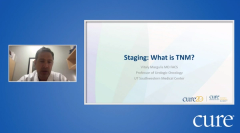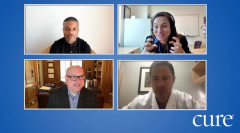
Educated Patient® Kidney Cancer Summit Surgical Options Presentation: April 9, 2022
Watch Dr. Jose Karam, from The University of Texas MD Anderson Cancer Center, discuss surgical options, during the CURE Educated Patient Kidney Cancer Summit.
Some patients with kidney cancer may have to undergo either a partial or radical nephrectomy to remove their tumor, and it is important to understand the risks and benefits.
“Patients should be informed of all available treatment options and be informed of the one that is felt to be most appropriate for their particular condition. Patients should ask their doctors about their experience in treating patients with kidney cancer, how many patients they see/operate on, etc.,” Dr. Jose A. Karam, an associate professor in the departments of urology and translational molecular pathology at The University of Texas MD Anderson Cancer Center in Houston, said in an interview with CURE®.
Karam discussed the surgical options for patients with kidney cancer further during CURE®’s Educated Patient® Kidney Cancer Summit, held virtually on April 9.
Partial Nephrectomy
This type of surgery would be best suited for patients who have smaller masses and are typically diagnosed with stage 1 kidney cancer, he explained. A partial nephrectomy consists of removing only part of the kidney that contains the tumor and is done either robotically (when small incisions are made in the abdomen and robotic surgical equipment and a camera can be inserted), laparoscopically (when short, narrow tubes are inserted through the abdomen through small incisions) or as an open setting (when a cut is made alongside or on the abdomen).
Karam explained during his presentation that this surgery usually takes about two to three hours, will only require a one-day hospital stay and a two- to four-week recovery time for the robotic or laparoscopic method. However, open surgery can take two hours, a three-day hospital stay and recovery time is four to six weeks.
The benefit of this type of surgery is that most of the kidney will be preserved — which is important for some patients with other comorbidities, Karam added.
“This is especially important in patients who have diabetes and hypertension, which are conditions that put patients at risk of kidney damage, so it is important to preserve kidney function for these patients, if possible,” he said.
Some risks that may come with a partial nephrectomy include delayed bleeding up to three weeks after surgery, which can result in lower back pain and blood in the urine; however, it can be managed by interventional radiology to preserve the kidney, and this only happens in about 1% to 2% of patients, Karam said. Another potential side effect associated with this surgery is urine leak, it only happens in about 1% of patients, but can cause lower back and abdominal pain as well as a fever and this may take a few weeks to resolve.
Results of a partial nephrectomy can often be equivalent to another surgery option, a radical nephrectomy, from a cancer control standpoint, Karam added. Meaning, some patients may have results of a radical nephrectomy but only have to endure the less invasive partial nephrectomy — however not all patients can qualify for this.
Radical Nephrectomy
Patients who do not qualify for a partial nephrectomy may have to turn to a radial nephrectomy, which is similar but includes removal of the whole kidney, instead of just part of it, as well as the fat around it. Generally, Karam explained, patients with larger tumors and stage 2 to 3 kidney cancer are candidates for this surgery.
“However, the treatment is more nuanced than this, and depends on many factors including patient factors and tumor factors,” he said. Some specific factors that he noted during the presentation included patient’s age, performance status, renal function, other comorbidities, other cancers and their wishes and expectations, as well as tumor size, location, growth and biopsy result.
The benefit of this type of surgery is the guarantee of removing the entire tumor because the whole kidney is being removed and nothing can be left behind in that area.
Karam noted that a risk of this surgery is the loss of kidney function, so patients will need to maintain their kidney function by leading a healthy lifestyle — which includes controlling their diabetes and blood pressure, as well as following up with their primary care doctor.
Additionally, post-surgery includes recovery in the hospital and following discharge instructions, which will may vary by patient. Patients will also need to keep up with postoperative visits, which includes exams and labs for active surveillance. This also may include adjuvant therapy, which is treatment given after primary treatment or surgery to keep the cancer away and was also discussed further during the summit.
For more news on cancer updates, research and education, don’t forget to
















